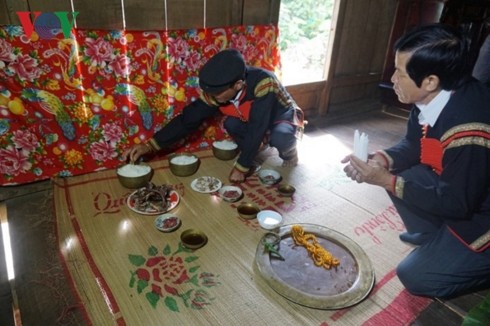(VOVWORLD) - The Ede ethnic group in the Central Highlands consider the Che, a big jar, a symbol of family wealth and prosperity. A Che full of alcohol is an indispensable item at all worship ceremonies. When they buy, sell, or give a Che away as a present, both the giver and the receiver perform a ritual to inform the family genies and ancestors of the event. It’s a custom of the Mdhur and Blo branches of Ede in Dac Lac province.
 A Che worship ritual. (Photo: H'Xiu/VOV) A Che worship ritual. (Photo: H'Xiu/VOV)
|
On a day early in the dry season, when people are enjoying leisure after the harvest, the Ede have organized a Che jar worship ceremony. At the house of Y Wut Mlo in Tai hamlet, the family is preparing for the ritual. The young men are helping the old people arrange gongs and Ches of alcohol and erecting a tall bamboo pole, called a Neu, which is believed to chase evil spirits away. In the kitchen, the women are cooking.
Y Wut Mlo says his family has had a year full of good luck and good health. Having extra money, he bought a new Che and organized a ritual to inform his ancestors of the purchase.
“We hold a ceremony to worship the soul of the jar we just bought. In the past my parents always worshipped to make new jars members of the family. Nowadays worshipping jars and gongs is not popular, but my family wants to preserve our traditional rituals for the children,” says Y Wut Mlo.
 A shaman prepares offerings for the Che worship ritual. A shaman prepares offerings for the Che worship ritual.
|
The Ede think that all things have souls. Legends say that Ches of alcohol are sacred items at worships, valuable gifts for special events, and the family’s contribution to community events. The offerings for a Che ceremony include a pig, 3 Ches of alcohol, 6 bronze bracelets, 3 strings of beads, 3 bronze cups, 3 bronze bowls, a bronze tray, and a branch of Chinaberry. The branch of Chinaberry is an intermediary item to connect men and genies and bring genies to the ceremony.
To the background sound of gongs, shaman Y Rung Ksor conducts the ritual on behalf of the house’s owner to welcome the new jar. The ancestors, the genies, and the jar’s soul are invited to the ceremony. From now on the family will treat the new jar like a member of the family. The shaman prays that the jar will live happily and harmoniously with the other family members. The shaman hangs bracelets and strings of beads on the jar, showing that it will be loved and respected as a member of the family.
Y Bon Mlo of Tai hamlet says this is the first time he has attended a jar worship ceremony.
“Young people like me watch the old people who are performing the ceremony. I note down everything, from the preparation of the offerings to organizing the ritual, hanging the alcohol bottles, and the shaman reading the prayer. I’ll save the documents for the next generation,” says Y Bon Mlo.
To end the ritual, the Ede beat gongs to thank all the relatives and neighbours for their attendance. Everyone will now sit around drinking alcohol from the jars and eating the offerings to congratulate the house’s owner on his new jar.